Great Expectations for Higher Education in the 21st Century
February 5, 2008
Great Expectations for Higher Education in the 21st Century
Amy Gutmann
President, University of Pennsylvania
Pullias Lecture, University of Southern California
It is an honor to be invited by the Center for Higher Education Policy Analysis (CHEPA), and doubly an honor to stand here today Super Tuesday in the tradition of so many eminent leaders of higher education who have delivered the Pullias Lecture over the past three decades, a tradition that remarkably includes presidents of USC, Stanford, Duke, University of California, City College of New York, Occidental, and Teachers College (Columbia) plus Chancellors of California State University and the California State and Community College System, not to mention so many great scholars of higher education and a former United States Secretary of Education.
My lecture takes off from one of the best known and most influential observers of the modern research university. Exactly five decades have passed since Clark Kerr became president of the University of California and began to redefine the nature and purpose of the research university.
Kerr held that American research universities are the opposite of single-purpose, internally coherent, organically united educational institutions. We are cities, Kerr said, of “infinite variety” (Kerr 2001, 31); we are “confused” (14) and internally incoherent; we lack a central animating principle or “soul” (1, 102) and we serve society “almost slavishly.” (14) As a consequence, Kerr famously concluded, we are “remarkably effective educational institution[s].” (14)
Kerr’s once shocking perspective has become mainstream, conventional wisdom. I want to ask: What should we think of this now conventional wisdom, the expectations that it sets for the American research university, and its implications for academic leadership?
Certainly American research universities today are still composed of very diverse institutional elements, including intensely pragmatic professional schools and applied science departments, intensely theoretical basic science departments, big and bottom-line driven health care systems, avidly impractical humanities departments, and social scientists of all stripes. Not to mention administrators, alumni, concerned community members and legislators, grateful patients, farmers and businesspeople, and—our core constituency that is neglected only at the greatest peril—students.
“A city of infinite variety… the multiversity,” Kerr wrote, “is an inconsistent institution…. It serves society almost slavishly—a society it also criticizes, sometimes unmercifully…. A community … should have common interests; in the multiversity, they are quite varied, even conflicting.... The university is so many things to so many different people that it must, of necessity, be partially at war with itself.” (7, 14-15) Kerr famously advised that “a university anywhere can aim no higher than to be as British as possible for the sake of the undergraduates, as German as possible for the sake of the graduates and research personnel, as American as possible for the sake of the public at large – and as confused as possible for the sake of the preservation of the whole uneasy balance.” (14)
Kerr went on to characterize the multiversity president not as “is sometimes said … a two-faced character … [but rather] a many-faced character…. The university president in the United States is expected to be a friend of the students, a colleague of the faculty, a good fellow with the alumni, a sound administrator with the trustees, a good speaker with the public, an astute bargainer with the foundations and the federal agencies, a politician with the state legislature, a friend of industry, labor, and agriculture, a persuasive diplomat with donors, a champion of education generally, a supporter of the professions (particularly law and medicine), a spokesman to the press, a scholar in his own right, a public servant at the sate and national levels, a devotee of opera and football equally, a decent human being, [here comes my favorite observation] a good husband and father, an active member of a church. Above all he must enjoy traveling in airplanes, eating his meals in public, and attending public ceremonies. No one can be all of these things. Some succeed at being none.” (22)
Accepting the complex, multi-purpose nature of the multiversity, applauding much of its multiplicity, acknowledging that universities therefore cannot have a simple, singular soul, and that university presidents cannot be all things to all people, I will urge us not to take several other of these observations qua objective observations at their face value. Second, I will question two major prescriptions that emanate from these observations: namely, that research universities must slavishly serve society and therefore be at war with themselves. Third, I will argue in favor of university presidents being first and foremost leaders of multiple constituencies rather than (as Kerr suggested) primarily mediators among multiple constituencies.
First things first, the ideal type of a multiversity: Can a university do no better than to be as British as possible for undergraduates, as German as possible for graduates and research personnel, as American as possible for the general public, and as confused as possible for the sake of preserving the whole uneasy balance? This observation is rhetorically brilliant precisely because it cleverly diverts us from recognizing that to establish a balance (even an uneasy balance), university leaders need to say what their universities are willing (and therefore unwilling) to do for various constituencies and why. We cannot possibly maximize all three of these variables, each of which is very resource intensive, internally various, and therefore cannot even be effectively pursued – let along maximized – without trade-offs.
For example: How much are we going to raise tuition for undergraduates whose families can afford to pay the sticker price of our education? How much will we raise financial aid for those students with financial need? Do we improve financial aid solely on the basis of need, or do we also increase merit-based and athletic scholarships as well? Will faculty salaries go up as much, more, or less than staff salaries? And how will these increases compare with graduate student and postdoc stipends?
How do we “balance” (85) these human resource priorities against those of maintaining and expanding our physical plants? This question by itself covers another huge set of internally competing priorities. What will we spend on research and teaching buildings? Undergraduate and graduate student housing? Athletic and fitness facilities? Recreational and green space? Space for future versus present expansion? What proportion of the present income on our endowment do we spend now and what proportion do we reinvest to ensure the university’s future well-being?
And what about our investment in Alumni relations? In community economic development? And we have not yet even gotten to curriculum development, new and improved academic programs, centers, and institutes. Not to mention expanding our global collaborations.
Be as British, German, and American as possible for each major constituency points in precisely the opposite direction of the idea of maintaining an uneasy balance. And both principles, on careful consideration, evade the issue of how we can best assess a multiversity’s competing priorities.
Another possible principle, which Kerr also suggested, is “preservation.” (77) The mantra of maintenance rests comfortably with how “conservative” (125) and slow to change (115) universities are said to be as institutions. (Former Duke President, Nan Keohane, tells of a trustee who said to her that the moment he hears the world is coming to an end, he will take up residence at Duke, because everything takes a year longer to happen there.) But maintaining the status quo also has two problems. Were it possible, which it is not, it would be undesirable because giving up on trying to improve what we have inherited is a recipe for inferiority if not extinction in a highly competitive environment.
Conservation pure and simple is impossible because the external environment of American higher education has been steadily changing, and in significant ways. Consider just a few of the sea changes that have occurred over the past 40 years in higher American education.
Enrollment in American higher education has more than doubled—from 7.5 million in 1968 to 17.5 million in 2005. (National Center for Education Statistics 2005, 14-15) [See Figure One]
Over the past forty years (between 1976 and 2005), female enrollment in first-professional programs increased 207 percent (from 54,000 to 167,000), while male enrollment decreased by 11 percent (from 190,000 to 170,000). Men outnumbered women in first-professional programs by 350 percent in 1976. Enrollment by gender is basically equal today. (National Center for Education Statistics 2007, 30, 131, 132) [See Figure Two]
In graduate programs, over this same period, female enrollment increased 112 percent while male enrollment increased 23 percent. Today, almost 50 percent more women than men today are in graduate programs (1.3 million compared to 877,000). (30, 131, 132) [See Figure Three]
Between 1971 and 2006, minority (non-white) undergraduate enrollments in higher education increased over 250 percent. In 1971, the freshman class was six-tenths of one percent Asian American/Asian (.06) and six-tenths of one percent Latina/Latino (.06). By 2006, the freshman class was 8.6 percent Asian American/Asian and 7.3 percent Latina/Latino. African Americans had increased from 7.5 to 10.5 percent, and American Indian went from under .09 percent to 2.2 percent. The overall freshman class went from more than 90 percent White/Caucasian (90.9) in 1971 to 76.5 percent White in 2005. (Higher Education Research Institute 2007, 1) [See Figure Four]
Over the last forty years (1963-64 to 2005-06), tuition and fees have increased over 18-fold for 4-year privates and over 21-fold for 4-year public universities. Financial aid has increased far more than tuition and fees. For the 25-year period from 1963-64 to 1988-89, total financial aid increased over 50-fold (from 546 million to 26.7 billion dollars). (Lewis 1989, 548) From 1963-64 to 1999-2000, federal aid alone increased over 200-fold, from 231 million to 47.7 billion. (Lewis 1989, 548; College Board 2000, 7) That’s the good news. The other financial aid news is that over the past 25 years need-based state grants rose more slowly than non-need-based state grants. Over the past decade (1995-96 to 2005-06) need-based state grant aid rose by 56 percent while non-need-based state grants increased by more than 250 percent. State grant aid is now almost as much non-need-based as it is need-based. ($1.4 billion as compared to $1.8 billion in 2006 dollars). (College Board 2007, 17; NASSGAP 2006, 2) [See Figure Five]
The number of colleges and universities has increased over 40 percent over the past forty years (1974-2005), from just over 3,000 to almost 4400. (SCUP 2006, 1) [See Figure Six] Our physical space has expanded by over 500 percent, from 1.3 to 6 billion net assignable square feet. (1) [See Figure Seven] Less noticed, but no less significant, the number of departments at many major research universities has increased, primarily reflecting not increasing specialization but rather “a blending of previously distinct fields to produce new areas such as biophysics and biochemistry and, more recently, neuroscience and photonics” (not to mention nanoscience, bioinformatics, media and film studies, genomics, and proteomics). (National Academy of Sciences, et al. 2004, 19) [See Figure Eight] At the undergraduate level, interdisciplinary honors programs proliferated “in the early 1980s at triple the rate of the 1960s and 1970s.” (Newell and Klein 1996, 153) Today, “interdisciplinary” has become the rule rather than the exception that it was in the 1960s, among scholars and students alike.
Few if any of these changes happened serendipitously. The most inexorable, perhaps, have been the changing demographics of undergraduate populations. But even these changes were the product of myriad policy and admission decisions, which might have been otherwise and certainly did not maintain the status quo ante. The slowest changes have been at the tenured faculty and departmental chair levels, but even here changes over the past 40-years have been considerable, with the greatest progress yet to be made at faculty levels in the STEM fields, Science, Technology, Engineering and Mathematics. (I won’t comment here on changes at the presidential level except to say that women and minority presidents of major research universities are as present today as we were conspicuously absent 45 years ago.)
There is so much more to be accomplished by way of simultaneously diversifying and improving the quality of universities that preservation alone cannot provide any president, or any of her constituencies, with an adequate let alone admirable vision of the multiversity moving forward. University presidents need to lead, and leadership requires that we defend priorities among competing goals.
This leads naturally to our second question: are the most defensible priorities those that serve society, rather slavishly, and are these priorities internally consistent? To be strong and viable over time, universities must serve society but primarily by taking a far longer-term view than the immediate demands of democratic governments and other societal groups typically try to pressure us into doing. One of the latest threats of regulation to come out of Washington would require universities with over half a billion dollars in endowment to spend at least 5 percent of the income on our endowment every year. In a society that suffers from a negative savings rate, and from a government that has the largest deficit in its history to deal with, the demand that universities spend more should raise some eyebrows out of academia. This shortsighted demand seems to stem from the reasonable idea that a university education should be made affordable to all qualified students, and therefore universities should spend enough of their endowment income to make their education affordable to all. This is an excellent example of how our serving society requires us not to give in to demands that would weaken our capacity to pursue our primary social purposes over time. It is also an example of how the long-term health of American higher education depends on clearly communicating our primary purposes and how we are organized to pursue them.
This brings me to the fundamental question: What purposes can and should unite the modern mature multiversity? One of our first and foremost purposes is to afford access to higher education to a diverse set of talented, hardworking students, regardless of their families’ income. We therefore need to communicate how we are organized to do this. For private universities like Penn, the priority of this goal has meant managing our resources and setting our other priorities in such a way as to save enough over time to increase our (solely) need-based financial aid at a faster rate than our tuition increases. If we are forced by a simple rule to spend more of our endowment income, across-the-board, most of which is restricted for purposes other than financial aid, then we will become educationally weaker, not stronger, over time, and less rather than more capable of ensuring access to low- and middle-income students in the future.
Are the other primary purposes of research universities consistent with the goal of increasing access? While it is impossible to maximize more than one (resource-intensive) primary purpose at once, it is both possible and desirable to defend a set of primary purposes that are symbiotic with access: they increase the value of access to our institutions. The three primary purposes around which the Penn community is united – which are articulated in what we call the Penn Compact are symbiotic in this sense, and they are by no means unique to Penn. Rather they are common to most American universities: increase access, integrate knowledge, and engage locally and globally. Our support for interdisciplinary scholarship and teaching, within and across schools, departments, centers, and institutes has burgeoned for the sake of expanding our understanding of complex and important problems. And our quest to understand complex and important problems also propels us to engage with local, national, and international communities, where our faculty and students learn at the same time as they contribute something to the world beyond our classrooms and laboratories. These three purposes, taken together, simultaneously expand the reach of our educational power to teach local, national, and global citizens and leaders; they improve the quality of the education we offer, the value of the research that we produce, and the long-term contributions that we make to many communities beyond our campuses’ physical boundaries.
Increasing access, integrating knowledge, and engaging locally and globally are very broad goals but they are not inclusive of everything that a university can credibly do. They suggest, for example, that while we should contribute some measure of “social welfare” to broader communities, we are no substitute for governmental and nongovernmental entities, for-profit and not-for-profit organizations whose primary purposes—unlike those of a research and teaching university—are maximizing their contributions to elementary and secondary education, health and human services, and/or economic development. The more universities become short-term service stations to society, the harder it will be for us to pursue an internally consistent vision that maximizes what we are best suited for delivering to society: access to the highest levels of multidisciplinary knowledge and understanding that have the greatest long-term potential for informing and improving societies and our world. Precisely because a democratic society’s demands on universities cannot be expected to be consistent over time or compatible with our teaching, research, and other primary purposes, our own internal clarity about our highest priority goals—coupled with our ability to communicate these goals in a persuasive way to our many external constituencies—becomes critical to the capacity of research universities to contribute maximally to society moving forward.
My third point now naturally follows: university presidents must primarily be priority setters, that is, leaders not mainly mediators. Yes, we must be able, indeed eager, to interpret the wants and needs of multiple constituencies (which perhaps too often are expressed as demands) to one another. And, yes, we must be willing to compromise in order to make progress on our primary goals. But our first task is not (as Kerr argued) “peace.” It is intellectual progress. And our second task is not peace. It is leading the kinds of collaborations across boundaries that, as many studies now confirm, multiply not only individual but institutional creativity and innovation. University presidents probably need to be pragmatic idealists: priority setters who push the limits of the possible and who primarily lead rather than manage the many other leaders in our institutions—our executive teams, faculties, students, and administrative staffs—to work avidly and intensely together on the many projects that contribute to our highest priority goals.
I suspect that I may have made the job of a university president seem, while complex, quite a bit easier than it actually is. Let me therefore bite the bullet. Today, as so often in the past, the battle-lines of conflict both inside and outside the multiversity are often drawn around the allocation of scarce financial resources. Penn is a good a case in point. While our $6.6 billion endowment has recently risen to the 9th largest endowment nationally, it is small per capita (only 61st in rank). Such resource scarcity is far from unique to Penn. It is the rule rather than the exception among research universities, and it puts a premium on presidents uniting as many constituencies as possible around our highest priority goals. To become educationally stronger and more socially valuable over time, we must not unnecessarily divert valuable resources to lower rather than higher priorities, let alone waste them.
What, very practically speaking, might this imply by way of presidential initiatives? Over the past three years, Penn has taken major steps toward ensuring access to a Penn undergraduate education regardless of financial background. We are substituting cash grants for loans for financially eligible undergraduate students, regardless of family income, making it possible for students from a broad range of economic backgrounds to graduate debt-free. (This will cost us approximately $20 million extra per year in undergraduate financial aid on top of our now $90 million undergraduate financial aid budget.) On the Integrates Knowledge front, we have created a new kind of faculty appointment, joint between schools, and initiated a faculty recruitment program called Penn Integrates Knowledge (PIK, for short). This program recruits eminent interdisciplinary faculty members to Penn who model multi-disciplinary research and teaching and hold genuinely joint appointments between two of our schools. (The price tag on this initiative is upwards of $90 million.) On the local engagement front, we have created a new master plan for our expanded campus, called Penn Connects, which will convert an ugly 10-acre asphalt parking lot into recreational and green space for our campus and city, stimulate billions of dollars of new local investment, create thousands of new jobs, and connect our campus better both internally and to Center City, Philadelphia. (The price tag on our new campus plan is upwards of $1 billion.) On the global engagement front, Penn faculty and students from across several of our Schools are partnering with the University of Botswana, along with Harvard and Baylor Universities, and the Merck and Gates Foundations, in order to help build both the country’s capacity to combat the AIDS epidemic and its first medical school. Our faculty and students credibly describe their experiences there as nothing short of “life transforming.” We are planning in-depth faculty-led capacity-building programs in other developing countries. (The price tag on this initiative is still to be determined, but certainly also in the millions.)
Each of these initiatives is an outgrowth of at least one of Penn’s highest priorities. And each involves a significant commitment of financial resources. [Penn is a very large institution (20,000 students and 25,000 faculty, staff, and employees), so there must be those who say the funds and energies devoted to access, the integration of knowledge, or local and global engagement could be more productively used.] How, some faculty ask, can a university have a strategic objective other than to support the individual quests of its faculty members? How, some students ask, can Penn raise tuition higher than inflation? As president, I undoubtedly hear only a fraction of the critical questions out there, but before I institute any costly initiative I try to address even the doubts that I do not directly hear.
The conventional wisdom, which Kerr was instrumental in establishing, says that large research universities like USC and Penn are amorphous collections of valuable pieces, pieces that are growing in number and diversity, but not bound together by any overarching vision of the university’s larger educational role or social responsibility.
However accurate this may be as a path of least resistance, it is neither the most desirable nor the most pragmatic path for great American universities (or colleges) to thrive over time. I have just barely sketched out here what I have found to be a path (not of less resistance but) of greater, long-term societal gain, a path of presidential leadership that speaks to inspiring, high priority purposes of universities and builds a highly collaborative effort that unites the university’s multiple constituencies behind these purposes that thereby become their own.
In addition to increasing access by increasing need-based financial aid, American universities have an enormous capacity, still largely untapped due to our organizational fragmentation, to integrate knowledge and understanding across fields, disciplines, and cultures. [CHEPA’s mission statement is exemplary in this regard.] The world has an increasing need for such integrated knowledge to address complex and important problems.
In addition to our uniting behind the university’s mission of providing access to higher education to talented students, we can also be united in pursuit of integrated knowledge and understanding for the long-term well-being of communities at home and around the world. To be united in this (or any other educationally worthy) way will require greater collaboration within, and probably also among, universities. This will happen as long as university presidents—along with many other academic leaders—lead in both very inspiring and highly collaborative ways. These are truly great expectations for higher education in the 21st Century. We owe our universities and the world no more and no less.
WORKS CITED
The College Board. 2000. Trends in Student Aid. Washington, D.C.: College Board.
The College Board. 2007. Trends in Student Aid. Washington, D.C.: College Board.
Kerr, Clark. 2001. The Uses of the University, fifth edition. Cambridge: Harvard University Press.
Higher Education Research Institute, University of California, Los Angeles. 2007. “The American Freshman Forty-Year Trends: 1966-2006.”
Lewis, Gwendolyn L. 1989. “Trends in Student Aid: 1963-64 to 1988-89.” Research in Higher Education 30: 547-561.
National Association of State Student Grant & Aid Programs (NAASGAP). 2006. 37th Annual Survey Report on State Sponsored Student Financial Aid: 2005-2006 Academic Year. February 5, 2008. https://www.nassgap.org/viewrepository.aspx?categoryID=3#
National Center for Education Statistics, U.S. Department of Education. 2005. Digest of Education Statistics. Washington, D.C.: U.S. Department of Education.
National Center for Education Statistics, U.S. Department of Education. 2007. The Condition of Education. Washington, D.C.: U.S. Department of Education.
Newell, William H. and Julie Thompson Klein. 1996. Interdisciplinary Studies into the 21st Century.JGE: The Journal of Education 45: 152-169.
Society for College and University Planning (SCUP). 2006. Campus Facilities Inventory (“CFI”), 2006 CFI Executive Summary. February 5, 2008. http://www.scup.org/knowledge/cfi/2006-CFI_executive-sum.pdf
FIGURE ONE
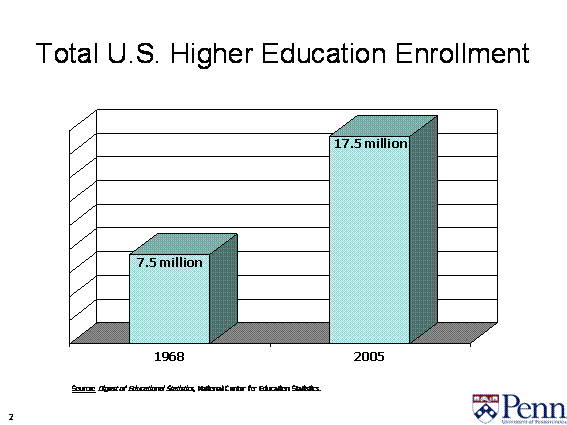
Total U.S. Higher Education Enrollment, 1968 and 2005
FIGURE TWO
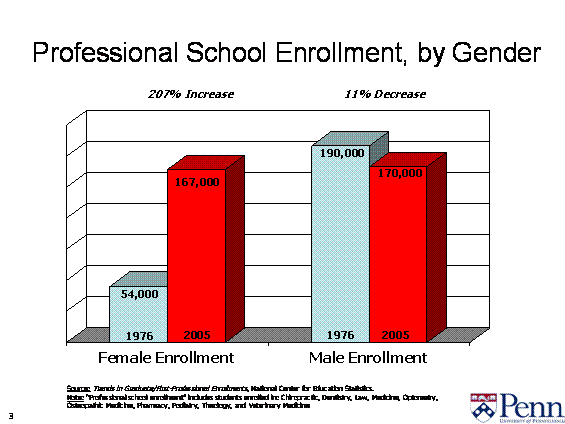
Professional School Enrollment, by Gender, 1976 and 2005
FIGURE THREE
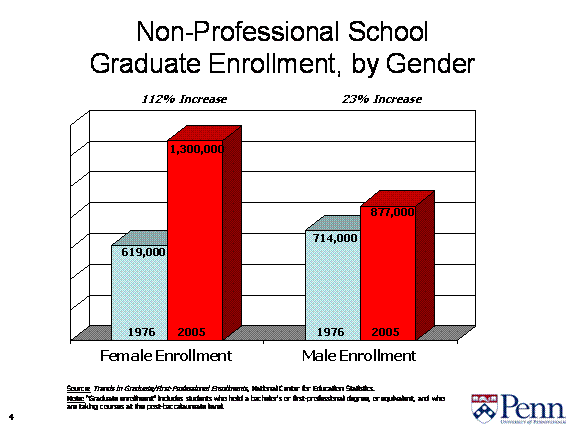
Non-Professional School Graduate Enrollment, by Gender, 1976 and 2005
FIGURE FOUR
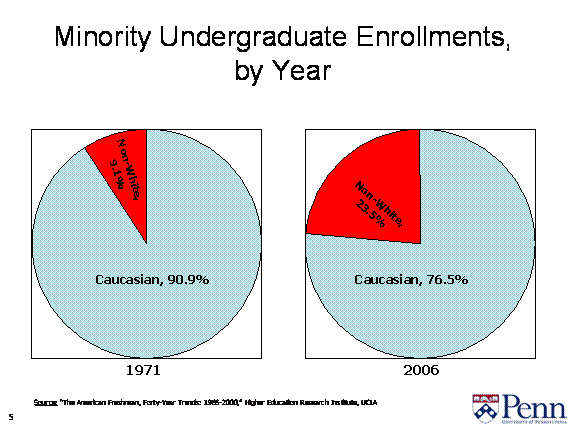
Minority Undergraduate Enrollments, by Year, 1971 and 2006
FIGURE FIVE
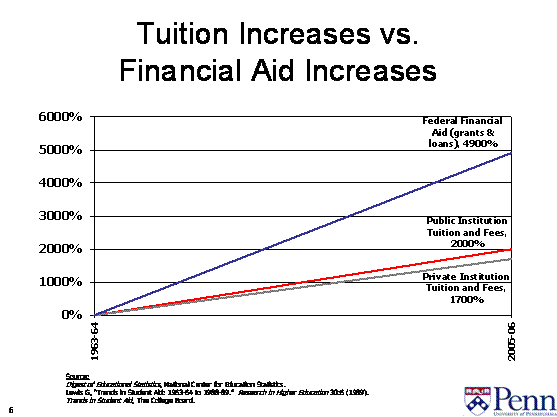
Tuition Increases vs. Financial Aid Increases, 1963-1964 – 2005-2006
FIGURE SIX
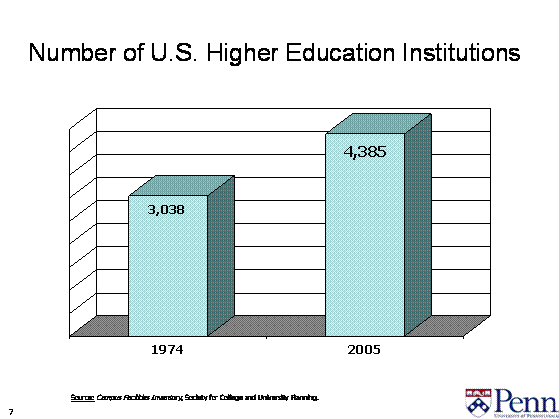
Number of U.S. Higher Education Institutions, 1974 and 2005
FIGURE SEVEN
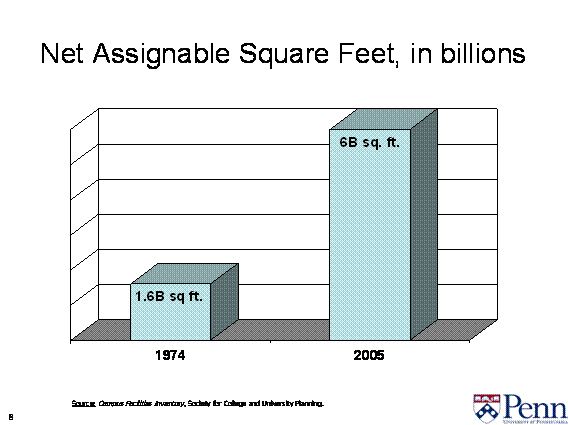
Net Assignable Square Feet, in billions, 1974 and 2005
FIGURE EIGHT

Number of Departments at Selected U.S Universities, 1900-2000